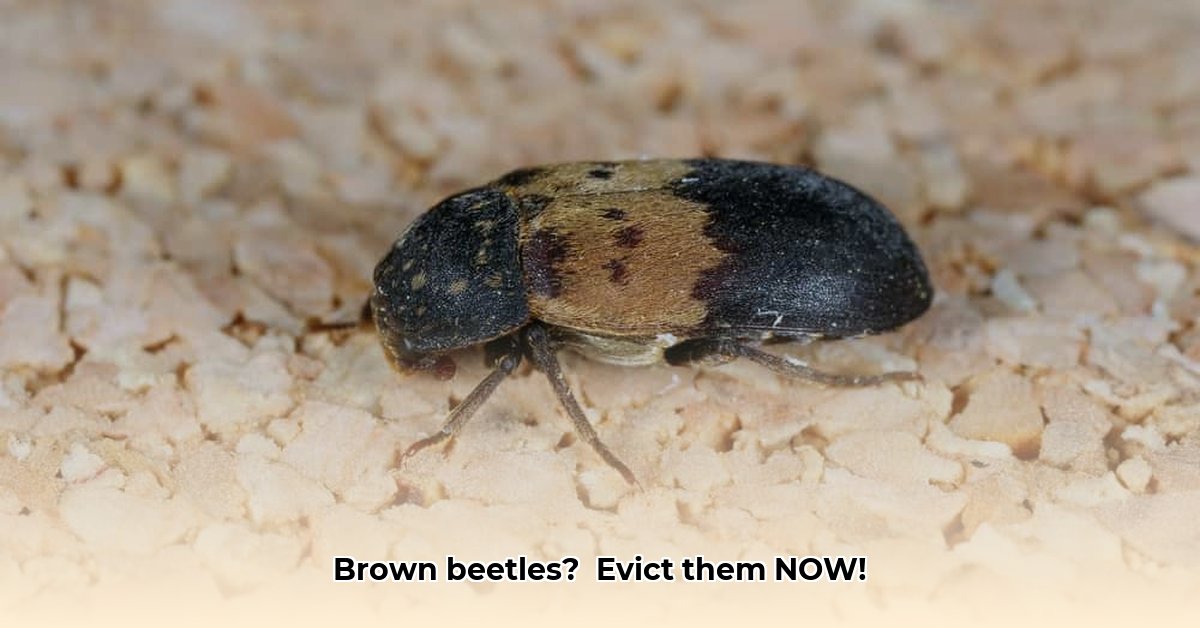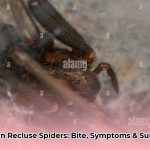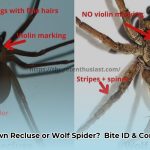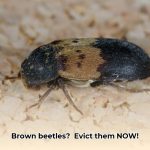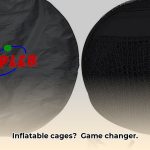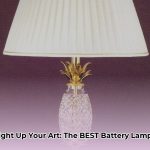Brown beetles in your home can be a nuisance. This guide helps you identify common household beetles, eliminate infestations, and prevent future occurrences.
Identifying Common Culprits
Correct identification is crucial for effective control. This guide covers common brown beetles, their habits, and how to deal with them.
| Image | Common Name (Scientific Name) | Size (inches) | Key Features | Typical Location |
|---|---|---|---|---|
| (Image of Varied Carpet Beetle) | Varied Carpet Beetle (Anthrenus verbasci) | ~0.1 | Oval, mottled mix of black, brown, and yellow | Carpets, fabrics, closets |
| (Image of Furniture Carpet Beetle) | Furniture Carpet Beetle (Anthrenus flavipes) | 0.06-0.12 | Small, rounded, dark yellow to orange, often with black and white dots | Furniture, fabrics, upholstery |
| (Image of Black Carpet Beetle) | Black Carpet Beetle (Attagenus unicolor) | 0.12-0.18 | Shiny black, dark brown legs | Closets, stored clothing, fabrics |
| (Image of Common Furniture Beetle) | Common Furniture Beetle (Anobium punctatum) | 0.11-0.18 | Dark brown, elongated, ribbed and pitted | Wood furniture, structural wood |
| (Image of Powderpost Beetle) | Powderpost Beetle (various Lyctinae species) | 0.12-0.25 | Varies; generally dark brown; look for fine, powdery sawdust (frass) | Wood beams, floors, furniture |
| (Image of Drugstore Beetle) | Drugstore Beetle (Stegobium paniceum) | 1/8 – 3/16 | Small, cylindrical, reddish-brown, saw-like antennae | Pantries, stored food, spices |
| (Image of Cigarette Beetle) | Cigarette Beetle (Lasioderma serricorne) | 1/8 – 1/4 | Oval, light brown, covered in fine hairs | Stored tobacco, dried spices, pantry goods |
| (Image of Red Flour Beetle) | Red Flour Beetle (Tribolium castaneum) | 1/8 – 3/16 | Flattened, reddish-brown, gradually clubbed antennae | Flour, grains, cereals |
| (Image of Larder Beetle) | Larder Beetle (Dermestes lardarius) | 0.33-0.37 | Black/dark brown, oval, tan/yellowish band with dark spots | Stored food, pet food, pantries, furs |
| (Image of Flour Beetle) | Flour Beetle (various Tenebrionidae species) | 0.12-0.18 | Reddish-brown, flattened oval, short, clubbed antennae | Flour, grains, pantries |
| (Image of Plaster Beetle) | Plaster Beetle (Cryptophagus cellaris) | 0.05-0.08 | Light brown, oval, grooved back with rows of pits | Damp areas, basements, attics, moldy areas |
| (Image of American Spider Beetle) | American Spider Beetle (Mezium americanum) | 1/16 – 1/8 | Round, reddish-brown, spider-like legs | Pantries, dark corners |
Detailed Beetle Profiles & Control
Carpet Beetles (Anthrenus species)
- Description: Small, oval, mottled patterns of brown, black, and white/yellow. Larvae are the destructive stage, feeding on natural fibers.
- Signs of Infestation: Damaged fabrics, shed larval skins, beetles themselves.
- Control: Thorough vacuuming, laundering/dry cleaning infested items. Insecticide sprays (for persistent infestations). Cedar may act as a natural deterrent, though research is ongoing.
Cigarette Beetles (Lasioderma serricorne)
- Description: Small, oval, light brown, covered in fine hairs.
- Signs of Infestation: Damaged tobacco, spices, dried flowers, pantry goods.
- Control: Store items in airtight containers. Discard infested products. Freezing can kill eggs/larvae. Consistent pantry cleaning.
Furniture Beetles (Anobiidae species)
- Description: Elongated, reddish-brown to dark brown.
- Signs of Infestation: Small, round exit holes in wood, powdery frass.
- Control: Control moisture. Professional treatment (heat or fumigation) is often necessary for established infestations.
Powderpost Beetles (Lyctinae species)
- Description: Elongated, reddish-brown to black.
- Signs of Infestation: Exit holes in hardwood, powdery frass.
- Control: Preventative wood treatment, maintaining dry conditions. Professional treatment often necessary.
Drugstore Beetles (Stegobium paniceum)
- Description: Small, cylindrical, reddish-brown, saw-like antennae.
- Signs of Infestation: Holes in food packaging, gritty droppings.
- Control: Discard infested food, deep clean pantry, use airtight containers. Sticky traps for monitoring.
Larder Beetles (Dermestes lardarius)
- Description: Larger, dark brown/black, pale yellow band with dark spots.
- Signs of Infestation: Holes in packaging, powdery dust, shed larval skins.
- Control: Discard infested items, freeze potentially infested items, clean thoroughly, secure pet food.
Flour Beetles (Tenebrionidae species) & Red Flour Beetles (Tribolium castaneum)
- Description: Reddish-brown, flattened oval, short, clubbed antennae (Red flour beetles reproduce very quickly).
- Signs of Infestation: Infested flour, grains, and other pantry staples.
- Control: Discard infested products, thorough pantry cleaning, use airtight containers.
Plaster Beetles (Cryptophagus cellaris)
- Description: Small, light brown, grooved back with pits.
- Signs of Infestation: Beetles in damp areas with mold growth.
- Control: Reduce humidity, fix leaks, improve ventilation, address mold issues.
American Spider Beetles (Mezium americanum)
- Description: Round, reddish-brown, long, spider-like legs.
- Signs of Infestation: Beetles scavenging for crumbs in pantries or dark corners.
- Control: Good sanitation practices.
General Prevention
- Regular Cleaning: Vacuum, clean spills promptly, eliminate dust and debris.
- Food Storage: Store food, including pet food, in airtight containers.
- Humidity Control: Use dehumidifiers, ensure good ventilation, fix leaks.
- Seal Entry Points: Seal cracks and crevices in walls, windows, and doors.
When to Call a Professional
- Severe infestations.
- Unsuccessful DIY attempts.
- Uncertainty about beetle identification.
- Suspicion of structural damage (furniture/powderpost beetles).
Frequently Asked Questions (FAQ)
-
Are brown beetles harmful? Most brown beetles are not directly harmful (don’t bite or sting). However, they can contaminate food, damage belongings, and some people are allergic to their debris. Some species, like powderpost beetles, can cause structural damage if left untreated.
-
What’s the most effective control method? The best method depends on the beetle species, infestation severity, and your situation. An integrated pest management approach combining multiple methods is usually most effective. Start with natural methods, escalate to chemical treatments, and consult professionals when needed.
This guide helps you manage and prevent brown beetle infestations. By taking a proactive and informed approach, you can maintain a beetle-free home. Remember, knowledge and prevention are key!
- Burning Plastic Smell in House: Causes, Solutions, and Safety Measures - April 8, 2025
- Best Bug Killer for Yard: Effective Pest Control Guide (2024) - April 8, 2025
- Brown Recluse Spider Bites: Identification, Treatment, and Prevention - April 8, 2025
